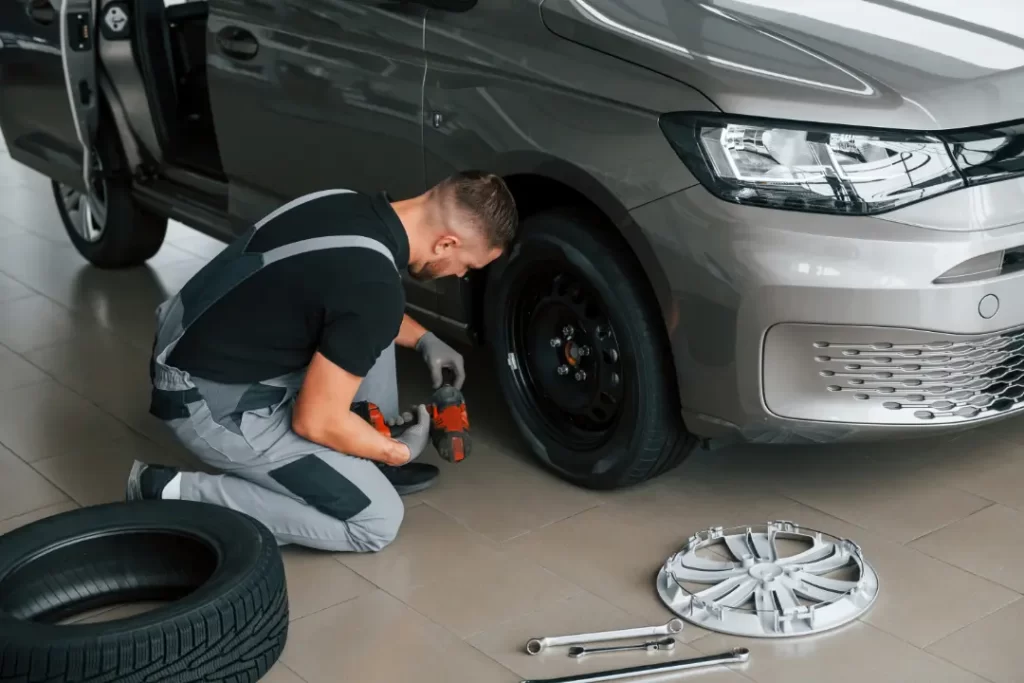A slow puncture is a gradual leak that reduces tyre pressure. This can compromise safety and handling without any obvious warning. Recognising the early signs of a tire leak can prevent roadside breakdowns, improve fuel economy, and save you from expensive repairs.
In this guide, you’ll learn about the common symptoms of a slow puncture, typical causes, DIY detection methods, options for professional repair and replacement, and proactive maintenance tips.
Key Takeaways
- Early detection saves money and reduces safety risks. Spotting slow punctures through frequent inflation needs, uneven tyre wear, or TPMS warnings helps prevent blowouts and costly repairs.
- Common causes vary. Nails, faulty valve stems, corroded rims, pothole damage, and ageing tyres are the main triggers for gradual leaks.
- Driving on a slow puncture is both dangerous and expensive. It reduces grip, increases stopping distances, raises fuel consumption, and can damage rims or lead to blowouts.
- Legal standards must be met. UK law requires a tread depth of at least 1.6 mm. Driving with defective tyres can result in £2,500 fines and 3 penalty points per tyre.
- DIY detection methods can be helpful but are limited. Regular pressure checks, soapy water tests, and visual inspections assist in locating leaks. However, a professional assessment is necessary for long-term safety.
- Professional repair or replacement is the safest choice. Minor tread punctures may be repaired. However, sidewall, bead, or severe damage always requires replacement.
What Are the Common Signs of a Slow Puncture?
A slow puncture shows itself through subtle tyre pressure changes that affect driving dynamics and fuel efficiency. Spotting these signs early ensures you can address the issue before handling or safety deteriorates. Below are the main indicators to watch for and why they matter.

Frequent Tyre Inflation
Frequent tyre inflation occurs when you add air more often than normal because the pressure keeps dropping due to a minor leak. For instance, if you need to add air every few days, it shows that your tyre cannot hold the right PSI, which increases the risk of underinflation.
Signs include:
- A visible drop in PSI overnight or after parking
- Dashboard TPMS alerts shortly after inflation
- Noticeable softness when you press the tyre sidewall
Recognising the need for constant air top-ups should prompt you to check for possible punctures and help prevent uneven wear.
Uneven Tyre Wear
Uneven tyre wear happens when one tyre slowly loses air, leading to more wear on the inner or outer edges. This pattern forms because underinflated tyres flex too much at the contact patches, creating heat and speeding up wear. For example, a tyre with low pressure on the inside edge will have more wear there compared to the rest of the tread.
Signs of uneven wear include:
- Inner-edge scalloping on front or rear tyres
- Feathered tread blocks on one side
- Excessive wear in the center if other areas are still legal
Uneven wear indicates ongoing air loss and shows the need for immediate pressure checks.
Vehicle Pulling to One Side
Vehicle pull occurs because a tyre with less pressure creates higher rolling resistance, steering the car toward that side. If your car drifts left or right on a level road without steering input, it indicates unequal tyre pressures. For example, drifting right on a straight road often means the right tyre is underinflated.
Pulling to one side not only affects comfort but also compromises braking stability, making early detection critical before handling degrades further.
Sluggish Handling and Steering Vibrations
Sluggish handling and steering vibrations occur when uneven tyre pressure disrupts balance. This causes irregular contact with the road surface. A tyre that is not shaped properly sends vibrations through the steering wheel at certain speeds. For example, a tire with low pressure may feel unstable in corners, which reduces responsiveness.
These issues require checking the tyre pressure with a gauge and performing a visual inspection to confirm or rule out a slow puncture.
TPMS Warning Light
A TPMS warning light activates when a tyre’s pressure falls below the manufacturer’s threshold, offering an electronic alert to gradual air loss. Since TPMS sensors monitor individual wheel pressures, a constant or flashing warning indicates a persistent leak or sensor fault. For example, a light that resets only briefly after inflation highlights an unresolved puncture.
TPMS warnings serve as an early diagnostic cue to inspect tyres and avoid unsafe driving conditions.
Hissing Sounds
You can find the leak location by looking for visible objects like nails or screws stuck in a tyre and by listening for faint hissing sounds. When you check the tread or sidewall, finding debris shows the cause. Listening closely can help you find where air is escaping. For example, if you press your hand near the leak, you might hear a faint hiss where air is coming out.
How to Perform a Soapy Water Test to Detect a Slow Tyre Leak?
- Mix a solution of water and mild liquid soap in a spray bottle.
- Inflate the tyre to the correct PSI.
- Spray the solution generously over the tyre tread, sidewall, and around the valve stem.
- Observe for bubble formation, indicating the precise leak location.
What Are the Most Common Causes of Slow Punctures?
Slow punctures originate from a variety of sources that compromise the tyre’s airtight seal, each introducing distinct risks and requiring targeted fixes. Understanding these causes helps prevent recurrence through informed driving and maintenance.
| Cause | Mechanism | Impact |
|---|---|---|
| Nails & Screws | Sharp objects penetrate the tread rubber | Gradual air loss over days |
| Faulty Valve Stem | Cracked or corroded valve allows seepage | Invisible leak at the bead area |
| Corroded Wheel Rim | Rust prevents proper tyre bead sealing | Intermittent pressure fluctuation |
| Pothole & Kerb Hit | Structural damage to bead or sidewall | Hidden internal cuts |
| Tyre Age & Wear | Rubber deterioration and micro-cracks form | Increased vulnerability to leaks |
Each of these factors demands specific corrective steps, from sealant application for minor valve leaks to full tyre replacement when bead sealing fails irreparably.
What Are the Dangers of Driving with a Slow Puncture?
Driving on an underinflated tyre lowers stability, increases stopping distance, raises fuel consumption, and raises the risk of sudden blowouts. Prompt action is essential.
Slow Puncture Compromises Vehicle Safety and Handling
A slow puncture puts safety at risk by reducing tyre grip, lengthening braking distances, and making cornering unstable. Underinflated tyres generate too much heat, increasing the chance of a sudden blowout at high speed. Spotting these dangers early can prevent serious failures that endanger the driver and passengers.
Slow Puncture Can Increase Your Fuel Consumption
A slow puncture increases fuel consumption because underinflated tyres create higher rolling resistance, forcing the engine to work harder.
What Further Damage Can Occur to Tyres and Wheels?
- Internal cord separation within the tyre structure
- Rim damage from the tyre bead slipping under load
- Uneven compound wear leading to irreversible tread degradation
Addressing a puncture quickly avoids these expensive and safety-critical failures.
What Are the Legal Implications of Driving on a Defective Tyre in the UK?
Driving with a defective tyre, such as one that is bald, damaged, or dangerously underinflated, can result in a fine of up to £2,500 per tyre and three penalty points on your licence.
UK law requires a minimum tread depth of 1.6 mm across the central three-quarters of the tyre’s breadth and around its entire circumference. Such tyres will also cause an MOT failure.
While a slow puncture or underinflation doesn’t automatically invalidate insurance or MOT status, insurers may reject claims if an unsafe tyre contributed to an accident.
How Can You Detect a Slow Puncture Yourself?
DIY detection empowers you to catch slow leaks before they become dangerous. Check your tyre pressures weekly with a reliable gauge, inspect the tread for nails, screws, or cuts, and spray soapy water around the tread and valve.
If you confirm a small puncture, tyre sealant or plug kits can provide a temporary fix. These work only on holes up to 4 mm wide in the tread area (not sidewalls). Follow the kit instructions: inject the sealant, rotate the wheel to spread it evenly, then re-inflate.
Keep in mind that sealant can interfere with TPMS sensors, and a professional inspection is essential immediately afterwards to ensure safe long-term repair or replacement.
Visual Checks to Spot a Slow Leak
Visual checks involve inspecting the tyre for embedded objects, unusual bulges, or sidewall cuts. Turn the wheel fully to examine inner shoulder areas and the valve stem for signs of corrosion. Early detection through sight alone often points to foreign debris requiring removal or repair.
Use a Tyre Pressure Gauge for Accurate Monitoring
A tyre pressure gauge provides precise PSI readings, enabling you to compare measured pressure against manufacturer specifications. Remove the valve cap, press the gauge firmly onto the valve stem, and read the displayed value. Record pressures weekly to track drops that suggest a slow leak.
Professional assessment ensures safe, lasting repair by checking tyre structure internally and verifying compliance with British Standard AU159. Qualified technicians can distinguish between repairable punctures and those requiring replacement, safeguarding your safety and vehicle performance.
What Are Your Tyre Repair and Replacement Options for Slow Punctures?
Repair or replacement decisions depend on the puncture’s size, location, and tyre condition, with clear criteria guiding safe outcomes.
A slow puncture within the tread area and under 6 mm in diameter can often be repaired safely using patch-plug methods.
However, punctures on the sidewall, near the shoulder, or exceeding repair limits demand full replacement to maintain tyre integrity.

Common Tyre Repair Methods
Professional repair techniques include:
- Plug-and-patch – combining a patch on the inside with a rubber plug through the tread
- Plug only – for very small punctures above the tread area
- Bead sealing – addressing leaks between tyre bead and rim
Each method restores airtight integrity and preserves tyre performance when conducted by certified technicians.
When Is Tyre Replacement Necessary for Slow Punctures?
Replacement is required for:
- Sidewall cuts or punctures
- Bead area separation from corrosion damage
- Tyre older than six years with multiple repairs
- Deep tread wear below legal limit
Replacing a compromised tyre prevents blowouts and ensures compliance with safety regulations.
All Vehicle Services: Sittingbourne’s Trusted Choice for Tyre Fitting, Replacement, and Mobile Tyre Support
When it comes to keeping your car safe and roadworthy, All Vehicle Services in Sittingbourne stands out as the garage people return to time and time again. We combine expert workmanship with high-quality tyres, fast turnaround, and unbeatable customer care, so you always know your vehicle is in safe hands.
Our team doesn’t just fit tyres; we provide peace of mind with every inspection, repair, or replacement we carry out. Whether you’re dealing with a slow puncture or uneven wear or need a full set of brand-new tyres, we’re equipped with the latest tools and genuine tyres to give you lasting results.
For busy customers, our mobile tyre fitting service brings our trusted expertise right to your driveway, saving you valuable time without compromising on quality.
- Expert tyre fitting and replacement carried out by trained, experienced technicians.
- Stock of authentic, high-quality tyres to match all budgets and vehicle types.
- Mobile tyre fitting service available across Sittingbourne for maximum convenience.
- Fast turnaround times so you’re never off the road longer than necessary.
- Transparent pricing with no hidden extras – what we quote is what you pay.
- Compliance with British safety standards for every repair and replacement.
- Local reputation for reliability, professionalism, and excellent customer service.
Every job we handle is done with precision, care, and the same attention to detail we’d give our own cars. Don’t settle for second-best when it comes to something this important. Book your tyre fitting or replacement with All Vehicle Services today and experience the excellence of Sittingbourne’s most trusted garage.
How Can You Prevent Slow Punctures with Proper Tyre Maintenance
Consistent maintenance minimises puncture risks by preserving tyre health, pressure, and structural integrity.
Checking tyre pressure monthly and before long trips ensures you spot gradual leaks early. Consistency in measurement time and method yields accurate trend data to preempt slow punctures.
Monitoring Tread Depth for Tyre Safet
Monitoring tread depth using a gauge or the 20p test confirms you remain above the 1.6 mm legal minimum. Adequate tread depth repels road debris and prevents objects from penetrating deeply.
Wheel Alignment and Balancing
Correct wheel alignment and balancing distribute load evenly across all four tyres, reducing hotspots of wear that invite cracking and punctures. Annual alignment checks keep steering true and tyre life extended.
Visual Inspections
Regularly scan tyres for cuts, bulges, sidewall abrasions, and embedded objects, paying close attention to high-stress areas. Early removal of debris prevents deeper penetration and air loss.
Good Driving Habits
Avoiding road hazards such as sharp debris, potholes, and aggressive kerb contact reduces tyre damage. Gentle cornering and cautious speed over rough surfaces extend tyre integrity.
Frequently Asked Questions About How to Spot a Slow Puncture
What is the most common sign of a slow puncture?
A slow, repeated loss of air pressure that needs frequent reinflation is the most common sign. This often comes with TPMS alerts or uneven tyre wear.
Can I drive long distances with a slow puncture?
No. Driving with a slow puncture risks blowouts, damages the rim, uses more fuel, and may void insurance if it leads to an accident.
Are tyre sealants a permanent fix for slow punctures?
No. Sealants are only a temporary solution and work on small punctures (up to 4 mm) in the tread. They do not fix sidewall damage and could affect TPMS sensors. You will always need professional repair or replacement.
How do I confirm a slow puncture at home?
Check the tyre pressure weekly, look for embedded objects, and conduct a soapy water spray test; bubbles will show where the leak is.
Can a slow puncture cause an MOT failure?
Yes. If a tyre is underinflated, damaged, or below the legal tread depth, it will lead to an MOT failure.
Conclusion
Slow punctures may seem minor, but they carry significant safety, financial, and legal risks if ignored. By recognising early signs like frequent reinflation, uneven wear, or TPMS alerts, you can act before problems escalate.
DIY checks help locate leaks, but lasting solutions require professional repair or replacement. At All Vehicle Services in Sittingbourne, expert technicians provide fast, compliant, and reliable tyre support, keeping you safe, road-legal, and confident behind the wheel.


